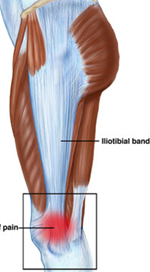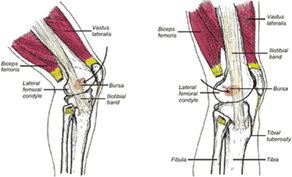The ITB (iliotibial band) is a band of fascia (connective tissue) that runs down the outside of your thigh from your hips to your knee. It crosses your knee joint on the outside and attaches to the lower leg bones. One of the roles of the ITB is to help bend your knee.
the outside of your thigh from your hips to your knee. It crosses your knee joint on the outside and attaches to the lower leg bones. One of the roles of the ITB is to help bend your knee.
Underneath the ITB, about 2cm above the level of your knee is a bursa which is a fluid filled sac. When you bend your knee the ITB moves and rubs over the bursa. If your ITB is too tight or gets overused, it can irritate the bursa and cause pain. This is called ITB friction syndrome.
ITB friction syndrome can be felt as an ache, sharp or burning pain on the outside of your knee. It may be accompanied by swelling and the symptoms often begin gradually and worsen over a few weeks. It tends to occur most often in activities requiring repeated knee flexion such as cycling or running and the pain tends to occur after about the same time or distance into the activity. The shape of your legs or the way your feet work can also increase your risk for this condition, as can some systemic inflammatory conditions.
 ITB behind bursa when knee bent, ITB in front of bursa when knee straight, so rubs bursa and can cause irritation with repeated bending and straightening.
ITB behind bursa when knee bent, ITB in front of bursa when knee straight, so rubs bursa and can cause irritation with repeated bending and straightening.
Treatment from home:
- Rest from aggravating activities
- Ice the area for 5-10 minutes at a time, several times a day
- Voltaren gel (if acceptable with other medications)
- Do all exercises and stretches recommended by the podiatrist
- Roll your ITB on a foam roller (not too hard!, you don’t want to cause more pain)
Treatment from the podiatrist is aimed at managing the cause, preventing recurrence and reducing symptoms and may include:
- Biomechanical assessment to determine if your foot or leg function or
- structure is aggravating or contributing to the cause of your pain.
- Taping
- Orthotics
- Dry needling or soft tissue therapy to help relax the ITB
- Recommendation of stretches and exercises to do to stretch and strengthen the ITB, gluteal, hamstring, and quadriceps muscles and to manage symptoms and prevent recurrence.

Comments are closed.